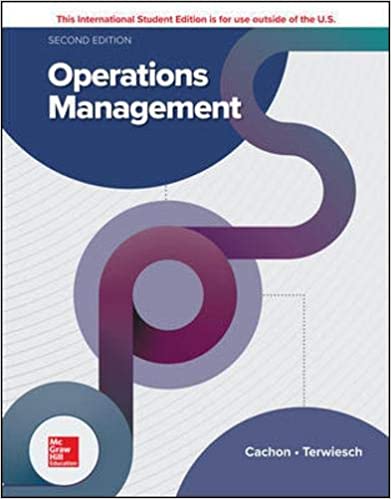Evaluate the impact of increasing the usage of the new kiosks. To do this, first draw a
Question:
Evaluate the impact of increasing the usage of the new kiosks. To do this, first draw a process flow diagram that combines the three different flows (traditional process, NEXUS program, new kiosks). Then, compute by what percentage the workload of the CBP officers would decrease if the usage of the new kiosks doubled (from the current 80 percent, 10 percent, and 10 percent for traditional, NEXUS, and new kiosks to 70 percent, 10 percent, and 20 percent).
On a typical day, more than a quarter of a million passengers and crew members arrive at U.S. airports, requiring the attention of U.S. Customs and Border Protection (CBP). For many years, this process was organized as follows. Passengers would move from their landing gates to the CBP officers. Passengers would then join one of two lines. U.S. citizens and permanent residents would be welcomed by one set of officers. Visitors from other countries would join another line leading to a separate set of officers. Typically, waiting times were longer for visitors than for citizens, though this could change depending on the day, and a substantial waiting time was possible for citizens as well as visitors. Because all visitors are fingerprinted, they take longer to be processed by the CBP.
In the early 2000s, the United States and Canada instituted the NEXUS program (initially known as the Trusted Traveler Program). The program allows eligible travelers who have been prescreened to bypass the lines using self-service technology at a number of kiosks. At the kiosks, the passenger answers a couple of questions, the passport and NEXUS membership card are scanned, fingerprints are scanned and compared to fingerprints on record, and a photo is taken. From there, most travelers can proceed directly to the luggage area. Only a randomly selected sample of passengers must be seen by a CBP officer.
In 2014, several airports, including Los Angeles (LAX), introduced an additional technology to streamline the process at CBP, creating a third flow of travelers. LAX, together with 20 other U.S. airports, allows eligible travelers to seek out a self-service kiosk. U.S. citizens and permanent residents are eligible, and so are travelers from 38 nations that are part of the U.S. waiver program. Similar to NEXUS, at the kiosks, passengers answer a couple of questions, their passport is scanned, fingerprints are scanned for non–U.S. citizens, and a photo is taken. At the end of their self–check-in, customers receive a printout that they then must personally present to a CBP officer. Passengers who have taken advantage of the kiosks require less time with the CBP officer, creating an overall increase in capacity and hence a reduction in waiting times.
For the following calculations, assume that
- It takes the CBP officer twice as long to process a visitor compared to a U.S. citizen or permanent resident. This is true for the traditional process, the randomly chosen passengers in the NEXUS process, and the new kiosk process.
- Eighty percent of the passengers use the traditional process, 10 percent use the NEXUS process, and 10 percent use the new kiosks. In each of these processes, the share of U.S. citizens and permanent residents is about 50 percent.

- Passengers spend no time with a CBP officer in the NEXUS process except when they are randomly sampled for an inspection. In that case, they spend the same amount of time with the CBP officer as in the traditional process. Five percent of passengers are randomly chosen for inspection (independent of being visitors or U.S. residents).
- Compared to the traditional process, passengers spend 50 percent less time when using the new kiosks (though U.S. residents still only spend half the time with the CBP compared to visitors).
Step by Step Answer:

Operations Management
ISBN: 9781260547610
2nd International Edition
Authors: Gerard Cachon, Christian Terwiesch





